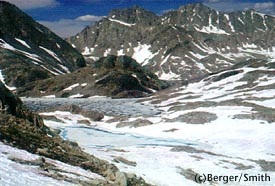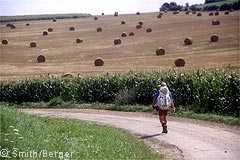I’ve always wanted to do a long hike. How much does long-distance hiking cost?
 |
| The High Sierra in June |
Good news and bad news: Let’s start with the bad news. Backpacking equipment can be quite expensive, especially if you go for the top-of-the-line stuff. So if you’ve got to start from scratch and you buy everything new, you can expect to spend at least $1000 on the basics: (tent, sleeping bag, pack, boots, stove, and raingear). That budget will get you solid middle-of-the-road gear, especially if you can hit some sales (Check out our article on cheap hiking gear for some ideas on stretching your budget). High rollers can easily spend $500 or even $1000 more. Then there’s clothing, pots and eating utensils, first aid and personal gear, maps and guidebooks, transportation expenses to and from the trailhead, and — don’t forget — food for 5 – 6 months, postage for resupply boxes, plus money for lay-over days in town.
Ready for some good news? Once you’ve bought your gear, your ticket, and most of the food you’ll send to yourself in resupply boxes, there isn’t much left to spend money on. Hikers figure $2.00 per mile and up for on-trail expenses. (Another way to figure it is $100 per town stop per person, if you’re staying in hostels or sharing hotel rooms with one or more other people; in some regions of the country, like new England, you’ll spend more.) Couples or hiking partners can lower the cost by sharing share some of those expenses, like the occasional night in a motel in town, or postage for sending unneeded equipment home or up ahead.
There are ways to minimize the expense. Some hikers make their own gear. Some cook and dehydrate most of their meals in advance. Some pay attention to their budgets during town stops by staying in campgrounds and hostels rather than hotels.
How do people manage that?
All different ways. Some save money for a couple of years by deliberately living a simpler life than they can “afford.” Some drive an older car or don’t go out to eat so much. Buying used gear is also an option (check the bulletin board at your local retailer, or join a hiking organization and list your request for gear in its newsletter). Many people sublet their apartments or rent out their homes while they are away.
How do you prepare for a long-distance hike?
The best favor you can do for yourself is to get in shape BEFORE your hike. Some hikers claim that that’s impossible: They say that the only way to get in shape to carry a pack up mountains all day is to carry a pack up mountains all day. I say hogwash! Sure, no matter how fit you are, you’ll have a few break-in days as your body gets used to doing something different. But there’s a huge difference in how you’ll feel if you start in good aerobic shape versus how you’ll fell if you start in slug shape. Believe me — I’ve done it both ways!
How many miles a day do hikers walk?
Depends on the terrain, the hiker, and the load you’re carrying. The average AT hiker completes the trail in about 5 1/2 months, which means averaging between 14 and 16 miles a day (it depends on how many rest-days, or “Zero” days, you take). The longer PCT and CDT have to be completed in about 5 months because of snow, meaning that the average mileage on those trails has to be higher — about 18 to 22 miles a day. That’s a LOT, by the way, if it’s not something you’ve ever done before.
Averages aside, there are huge variations in how much mileage people can do. Some extremely fit and motivated hikers cover 30, 40, or (very very occasionally and often painfully) even more miles a day. The most I’ve ever done was 35 miles with a VERY light pack, and I wasn’t happy at the end of the day! But on easy terrain when I’m broken in, I can comfortably do mileage in the mid-20s. But not day after day after day.
When you think about mileage, though, always consider the terrain and the elevation gains. Most people can cover 30 – 50 percent more mileage on the PCT than on the AT because the grades are more gentle and the footway is smoother.
How do I know how many miles a day I can walk?
You’ll learn from experience. People who complete long-trails are by and large just average folks of varying ages and fitness levels. If you are reasonably fit, and don’t have any specific problems, there’s no reason to think you can’t do the “average” required mileages listed above for the three trails. Of course, the point of a long-distance hike is the quality, not the speed with which you get to the destinations. You may well find that you enjoy a more leisurely page. On the PCT and CDT, that may mean that you’ll have to complete the trail over two seasons.
When you start your hike, plan for some low-mileage break-in days if possible. (On the AT, it’s a good idea to plan 10-mile days for the first week or so. It’s not always possible to do this on the PCT and CDT because of the distance between water sources.) And don’t forget to factor in the terrain: More mountains means less miles!
How many pairs of boots do you wear out?
It depends on the type of boot and which trail — and on how you walk and how much weight you carry. The AT is the hardest on boots because it has the rockiest, muddiest, and gnarliest footway of the three trails. However, it’s also shorter. If you use old-fashioned leather hiking boots, figure that you’ll need two pairs. If you’re using trail runners or sneakers, you may go through three or four pairs. If I’m using (lightweight) boots, I always break in two pairs of boots before a thru-hike, but this may not work for everyone because if it’s your first thru-hike, your feet may grow a full size (or even more) during the trip.
What do you eat on the trail?
Some hikers find that packing ALL their food in advance is a bad idea. Your body’s needs and tastes may change over the course of a hike. You might get sick of all that Ramen you packed six months ago!
Some staples you’ll see a lot of: Pasta. Lipton noodles-and-sauce packages. Ramen noodles. Instant oatmeal. Instant potatoes. Freeze-dried meals. Stove-top stuffing. Dehydrated meats and veggies. Snickers Bars. GORP (Good old raisins and peanuts). Crackers and cheese. Salami or similar sausages. Peanut butter and jelly. Instant soup mixes. Most of these are available in stores in towns along the way. You might also carry some fresh veggies (onions and carrots last well) for a little variety. Or dehydrate your own food.
Have you seen bears?
Yes, on all three of the Triple Crown trails. Bears are wild animals and will usually run from people. However, they can become problematic if they are defending a food source such as a berry patch or a cache of carrion, if they are surprised or frightened, or if a mother bear perceives you as a threat to her cub. If you see a cub, remember that Mama Bear is undoubtedly around and watching you very closely — retreat so she doesn’t feel threatened.
Over the years, bears have learned that backpacks are a great food source! They may try to get at your trail rations. In bear country, hanging food high in a tree using the counterbalance method is always a good idea, as is cooking and eating 100 yards away from your campsite. In “bear problem” areas such as Yosemite, Kings Canyon, and Sequoia National Parks, bears may be more aggressive and the park may provide bear lockers for food storage or have regulations requiring the use of special bear-proof canisters.
Do you worry about safety?
Backcountry travelers should always be attentive to safety because if you get into a jam you may have to be the one to get yourself out of it. That means being careful crossing tricky terrain like snowfields and rivers. It means keeping an eye on the weather. It means paying attention to where the next water source is. And it means exercising common sense when dealing with strangers. All that said, I feel safer in the backcountry that on a city street.


